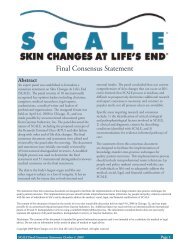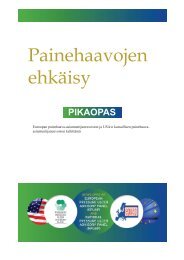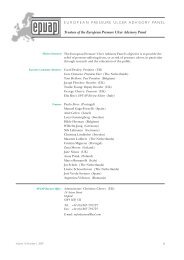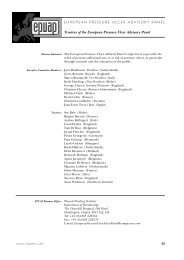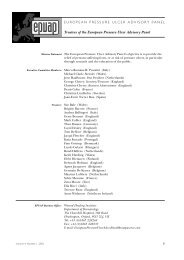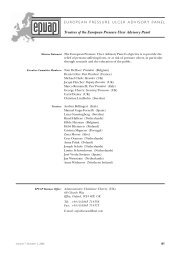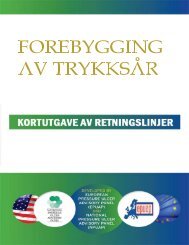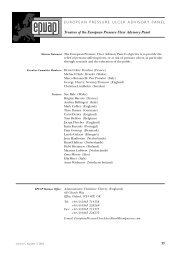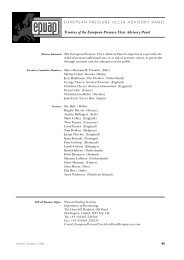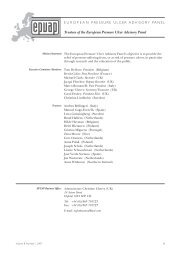Review 6.2 - European Pressure Ulcer Advisory Panel
Review 6.2 - European Pressure Ulcer Advisory Panel
Review 6.2 - European Pressure Ulcer Advisory Panel
Create successful ePaper yourself
Turn your PDF publications into a flip-book with our unique Google optimized e-Paper software.
EUROPEAN PRESSURE ULCER ADVISORY PANEL<br />
Discussion: These data will help in planning future continuing<br />
education programmes for staff level nurses to enhance<br />
pressure ulcer care.<br />
A PHENOMENOLOGICAL STUDY TO<br />
EXPLORE THE EXPERIENCE OF LIVING WITH<br />
A PRESSURE ULCER<br />
C. Dealey, A. Hopkins, D. Colin, T. Defloor<br />
Background: Little is known of the impact of pressure ulcers<br />
on an individual’s quality of life. This phenomenological<br />
study set out to investigate the impact of pressure ulceration<br />
on a variety of people with different underlying pathologies<br />
from several countries across Europe. This paper is<br />
reporting the first stage of the study, testing the impact of<br />
having multiple data collectors and translation from one<br />
language to another for analysis as well as the findings from<br />
eight patients.<br />
Methods: Patients over the age of 65 years, with a grade 3 or<br />
4 pressure ulcer which had been present more than one<br />
month, were recruited to the study. Each patient was interviewed<br />
using an unstructured format. The interviews were<br />
taped and then transcribed. The transcriptions were sent<br />
to one person for analysis. Standardised training was given<br />
to all those undertaking the interviews. Following analysis<br />
the emerging themes from each interview were examined<br />
with the interviewer to ensure validity. Transcripts that were<br />
translated into English were verified by the interviewer for<br />
accuracy.<br />
Results: A total of eight patients have been recruited from<br />
four centres, three in the UK and one in Belgium. Emerging<br />
themes from the interviews are pain, sudden loss, restriction<br />
and equipment, Discussion of the results will focus<br />
on the issues of validity that arise from a pan-<strong>European</strong><br />
qualitative study, in particular the cultural and translation<br />
influence within interview based methodology and the reliability<br />
of the emerging themes within a population that have<br />
multiple pathologies.<br />
THE EFFECT OF CLOTHING ON THE<br />
MEASUREMENT OF INTERFACE PRESSURE<br />
J.M. Melhuish, M. Clark, R.J. Williams, K.G. Harding<br />
Introduction: The measurement of interface pressure between<br />
subjects and associated support surfaces has been<br />
exhaustively researched. The effect of clothing on these<br />
measurements has been discussed but there is little work<br />
that has examined the effect on measured interface pressure.<br />
It is known and we have demonstrated that measured<br />
interface pressure is dependent on the hardness of the support<br />
surfaces for most types of sensors.<br />
Aim: To examine the effect of clothing materials and associated<br />
clothing structures (ACS) in a controlled environment<br />
on the measured interface pressure.<br />
Method: Synthetic mixes, Various Cotton garments and sheets<br />
were selected for testing. Small pieces of material approximately<br />
20 x 20 cm were cut from each garment. Measurements<br />
were undertaken on the plain material, a 1.5 cm<br />
folded crease, seams, pockets and buttons. The materials<br />
were placed as a sandwiched between two layers of foam<br />
(Shore “00” hardness 42) and two 10 x 10 cm metal plates.<br />
The plates were then loaded to apply 50 mmHg. Interface<br />
pressure was measured using a Tally Oxford pressure monitor.<br />
One piece of material and its ACS’s was tested using 7<br />
foams of increasing hardness, (shore 16–50 “000” scale),<br />
loading 25mmHg.<br />
Results: The Median (Range) of the measured control interface<br />
pressure was 50 (50–50)mmHg. Their was little effect<br />
shown on the measured interface pressures for plain<br />
materials 50 (45–54) mmHg. Their were varying affects for<br />
the ACS’s, not including buttons, 64.5(42–148) including<br />
buttons 68(42–310). Increasing foam hardness was associated<br />
with increasing measured interface pressure this became<br />
more pronounced for the ACS’s. For plain material,<br />
structures and buttons these were for foam 1 (hardness 16<br />
“000”) 12(12–13) 13(11–16), 28(27–29)mmHg, and for<br />
foam 7 (hardness 50 “000”) 23(23–24), 27.5(22–50), 113<br />
(113–11 5)mmHg.<br />
Conclusion: Clothing has a variable effect on the measured<br />
interface pressure this being very small for plain surfaces but<br />
can be greatly increased over associated material structures.<br />
PRESSURE ULCERS I (QUALITY OF LIFE) THE<br />
NEXT STEP: USING LARGE DATABASES TO<br />
MEASURE QUALITY OF CARE<br />
D. Berlowitz (US)<br />
Information on pressure ulcer status is increasingly available<br />
from large databases and is often considered for use<br />
when assessing the quality of care. In the United States,<br />
current initiatives are using data on pressure ulcers from a<br />
variety of settings including nursing homes, home care, and<br />
acute care hospitals. A basic understanding of the strengths<br />
and weaknesses of these data are essential if one is to develop<br />
a comprehensive understanding of the quality of care.<br />
Among the issues are the reliability of the data; whether<br />
the data provides an accurate description of the quality of<br />
care; how best to inform providers and consumers on performance;<br />
and optimal means to using these data in assessing<br />
and improving care.<br />
PRESSURE ULCERS 2 (EDUCATION AND<br />
GUIDELINES) QUALITY CF NATIONAL AND<br />
INTERNATIONAL GUIDELINES: A REVIEW<br />
M. Clark (GB)<br />
Many national and international guidelines have been produced<br />
that seek to assist pressure ulcer prevention and<br />
management. While there is considerable convergence between<br />
guidelines with recommendations offered primarily<br />
on the basis of expert opinion there has been no attempt<br />
to compare the quality of different guidelines. Until recently<br />
the lack of comparisons of guideline quality may have<br />
stemmed from there being no accepted audit tool with<br />
which guideline development and content could be assessed.<br />
The release of the AGREE instrument (http: www.<br />
agreecollaboration.org) in 2001 provides an approach allowing<br />
the quality of clinical guidelines to be assessed. This<br />
presentation will report the process and results of a comparison<br />
of three pressure ulcer guidelines (developed by<br />
50<br />
Volume 6, Number 2, 2004



